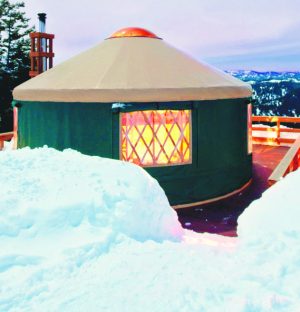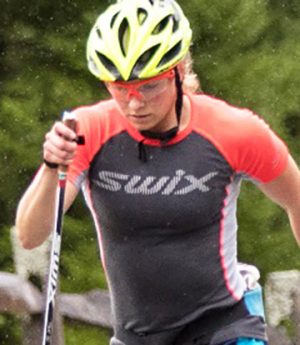Aug. 6 (Park City, Utah) – From on-snow training and some ocean fun in June to intense testing and roller-ski workouts. That was the transition for U.S. Ski Team cross country athletes in their latest camp where their third round of testing showed continued improvement
“We’re ahead of where we were a year ago…and that’s what we want,” said Head Coach Pete Vordenberg. “I keep telling people, when they ask, ‘It’s only July. Let’s not forget that’ – but, yeah, we’re in a good place.”
The two-week camp in Park City was a solid mix of testing – the third of four preseason testing sessions – plus roller-ski workouts at the newly expanded, paved 1.5K loop at Soldier Hollow, a taxing, uphill track largely funded by the U.S. Ski and Snowboard Association at the 2002 Olympic venue and extending the paved loop system to 7.5 kilometers.
Vordenberg said the challenging terrain of the new loop already is paying dividends because his skiers push themselves harder to master uphill technique while it also provides a safety element, reducing their roller-skiing on public roads. The camp also was a springboard for many of the athletes, who headed to New Zealand this week for the annual on-snow camp, held each August.
Coach: “The payoff is…”
“We’ve had a lot of good workouts, ” he said. “But the payoff is that the testing was good. It shows us we’ve made progress on some things and there are things we need to work on. It’s time to make the transition to those other aspects of physiology. It’s a good snapshot of where we are and what we need to work on next.”
The Continental Cup squad came in first in mid-July and then World Cup skiers came to Park City nearly a week later for the final sessions. The Team’s June camp departed from traditional preseason workouts as it mixed on-snow training at Oregon’s Mt. Bachelor and dryland drills on the Oregon coast, giving the athletes a different “stage” with some valuable cross-training. “Down on the coast, in the ocean or on the beach, turned out to be a real energizer for them,” the coach said.
The camps showed two ways to boost training results. “It was a different way to get intensity, and it kept their focus and level of training up. The change of scenery was great; it boosted their training and was outstanding,” Vordenberg added, “and so was this camp.”
“This is what we do three or four times a year,” said two-time Olympian Torin Koos (Leavenworth, WA). “We did the same tests after long-distance nationals [last March at the Maine Winter Sports Center’s Nordic Heritage Center in Presque Isle, ME]; we came back to Utah for three or four days and did the testing. We wanted to see how our training was holding up at the end of the season and where we can make improvements.
“The training’s pretty basic – roller-skiing, running, some strength training, some testing – and just ‘Get at it!’ You want to be firing,” said Koos, who produced his first World Cup podium last January during a sprint in Estonia.
Treacherous treadmill tests Team
One of the devices the athletes use in testing is an oversized treadmill in which they can roller-ski on a deck to measure their endurance. The revolving surface – obtained after the 2006 Olympics – may be elevated to increase intensity. Nordic combined skier Bill Demong (Vermontville, NY) has credited the treadmill with helping him collect a silver medal at the 2007 FIS Nordic World Ski Championships last March in Japan.
“I hang on as long as I can before it spits me off the back,” Koos laughed. “When we start going hard, they ratchet it up one degree for every minute; we do a lactate test…and we’ll be crossing through the lactic acid threshold as we’re picking up speed…and then we go back and test again.
“The whole Ski Team is urging you on – everyone’s yelling, we all do it for everyone – and there’s full commitment, so you don’t want to let yourself or anyone else down,” Koos said. “It gets intense.”
Alexa Turzian (Sun Valley, ID), the defending U.S. 10K champion – a title she won last January during the U.S. Championships at Michigan Tech when she was a high school senior, is a new member of the Ski Team. She was pleased with the camp. “This has been my first real time to train with the Team. It’s been great,” she said.
“I’m definitely used to the hard training, and that definitely set me up as far as testing and finding your levels and regulating your body,” she said.
Bound for Middlebury College this fall, Turzian said the first week “was pretty much like normal training, but it’s great to be with this group. There are heavy loads but since we have time to rest and recover, it’s been great. There’s been a lot of team bonding, which was really good for me. I knew everyone but I’d never hung out with them. [The second] week was a total change of pace with the treadmill testing, strength testing…”
Turzian eyes quality, not quantity training
Being named to the Ski Team, she said, means she probably will train about the same amount of hours, “but I’m focusing more on each workout, concentrating on getting my full level in during each workout.”
Vordenberg said the fall schedule includes an October camp in Lake Placid, NY, with some sessions with the U.S. Nordic Combined Team.
Otherwise, after returning from New Zealand later this month and then training with their home club programs or independently, Ski Team athletes will return to Park City for a final preseason testing camp. The data will be analyzed and compared next spring with athletes following a winter of competition.
When he took over the Team a year ago, Vordenberg said the first goal was to be better conditioned every season. So far, so good.
XC Testing Camp Details Progress
release by USSALeave a Reply
You must be logged in to post a comment.






![National camp action [P]...](https://skitrax.com/wp-content/uploads/2019/08/Duluth-4-2019-08-08-at-10.46.51-AM-300x246.png)
![Matt Liebsch on the CXC Elite Team [P] CXC...](https://skitrax.com/wp-content/uploads/2019/08/Matt-Liebsch-CXC.2-525x700.4-300x267.jpg)
![Dan LaBlanc [P]...](https://skitrax.com/wp-content/uploads/2019/08/Dan-LaBlanc-img_1855.3.jpg)
